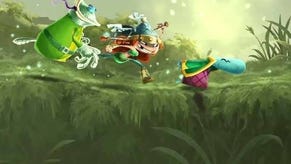FIFA 13 Preview: Your Team-Mates Have Woken Up!
Attacking Intelligence feels like the stand-out feature after a dozen matches.
At the time of writing, EA Sports has already unveiled a handful of fairly influential changes to the FIFA formula for this year's iteration, but after playing a dozen or so games of FIFA 13 the one that really stands out is the one with the least exciting name: Attacking Intelligence.
Although FIFA 12 was a wonderful football simulation in a lot of ways (and an even more wonderful platform for synchronised physical comedy), it wasn't without its annoying quirks, one of which was that you would often find yourself short of support from team-mates once you crossed the halfway line, forcing you to hold up play in hope of attracting reinforcements.
The idea was that Attacking Intelligence would bring more players into the attack, allowing you to sweep forward in waves, exploiting space between isolated and retreating defenders, and crash against the opposing penalty area with enough force to hoover up any rebounds or shots spilled by the goalkeeper.
Well, playing is believing. Playing as AC Milan in a pre-E3 multiplayer build, I would pick up the ball as Zlatan Ibrahimovic near the halfway line and immediately find the likes of Alexandre Pato, Robinho and even Luca Antonini racing up from defence to support. In FIFA 12 you could usually find a team-mate the first time you needed one; in FIFA 13 you can find people after that, strengthening the attack and creating new opportunities. Gentler arcs on lofted through-balls also hasten your counter-attacks, adding more thrust.
Another issue in FIFA 12 was one of those things that you only really notice after months of play: the certainty with which players bring the ball down and the limited range of ways to move away with it. Sure, there were lots of variations to the first touch and trick-stick controls, but not enough that you didn't feel the artificial, geometric precision of it after a while.
FIFA 13 also injects another dose of something the development team always used to talk about in reverent tones whenever I was invited round to see them: human error. The players' attributes and their situation - pace on the ball, angle of receipt, etc - now help to determine the quality of the first touch. It means that while more players will support your attacks, you still have to pay attention every step of the way.
You can't rely on your previously impeccable twinkle-toes dribbling to slalom through packed midfields and penalty areas now, either, because that tailored first-touch control seems to go beyond simply receiving the ball - almost every dab of the ball during a dribble is slightly imperfect, increasing the risk of going it alone.
That's potentially good news for people who struggled with last year's Tactical Defending system, too, and sometimes came unstuck because they couldn't get the movement and timing right to stick out a foot against weaving opposition attackers. Now that the attackers have less certainty of control, it's easier to shepherd them around with the jockey press and then catch them out if they dwell too long on the ball.
Counteracting this, on the other hand, is something called Complete Dribbling. In theory this is meant to be a bit like FIFA Street control: clamp both shoulder buttons and your player orientates himself face-on to the goal and you can use quick motions of the left analogue stick to jink and weave past whoever's in front of you. It's interesting and potentially lethal in the penalty area, although only time will tell how well balanced it is, and unfortunately a dozen matches wasn't long enough to make up my mind.
There are some defensive tweaks too. Last time out, you could jostle the man in possession without explicitly tackling or sliding in, and occasionally loosen the ball from his control, but now this kind of pressing is more explicitly a case of pulling on another player's shirt. It does haul them back, but if you do it too much you will be penalised. It's quite easy to fall foul of this and the referee will book you for it without much provocation.
Other explicit changes include new set-ups at free kicks. Bring a defender alongside the pre-existing wall and he will line up as part of it, and you can also assign somebody to close down the ball at the point the kick is taken. It's still possible to jump the wall, too, although remember not to go early or else you'll be in disarray when the shot comes in. Attackers, meanwhile, can bring other players into play, although I didn't get much time with this. (My opponents did, mind you - I had five players sent off during my games. What can I say? I like to push the boundaries and see what happens.)
To freshen things up further, EA's animators have also clearly been hard at work filling out the range of contextual movements each player makes during a game. This sort of thing rarely gets a bullet-point on the PowerPoint, but it's hugely noticeable when you pick up FIFA 13 for the first time after months with its predecessor, and has gameplay implications too. No longer, for example, are you guaranteed to get clattered every time you try to turn beyond a sliding defender - instead you might find you dance past him automagically. It's one of those things that makes you go "ooh!" the first time it happens.
Early impressions are that FIFA 13 is more fun to play, then, with Attacking Intelligence making the most difference. It reduces the distance between midfield and attack by making players position themselves for potential second and third balls, reducing the frustration and attrition of slower-paced advances and heightening the excitement in fast teams. The other changes leave their mark too, although we'll need more prolonged exposure to measure the extent of their repercussions.
Of course, there's always the sense that any kind of change is novel and welcome in a new FIFA game after months playing the previous one, and it's also quite telling that going back to FIFA 12 after an afternoon with the sequel is nowhere near as difficult as regressing to FIFA 11 was in the same situation. But it's also fair to say that FIFA 13 has a lot of promise. We'll reserve judgement until we've had a chance to play more of it and to put it up against Konami's reinvigorated Pro Evolution Soccer.









